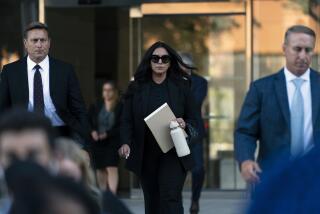Simpson Photo Analyst Assailed as Unreliable
- Share via
O.J. Simpson’s photo expert came under fierce attack Friday, as an opposing attorney sought to paint him as an unreliable conspiracy nut without any training in analyzing snapshots to ferret out forgeries.
In a pounding cross-examination, attorney Peter Gelblum worked to dismantle the credibility of Robert Groden, the photo analyst who told jurors this week that he saw signs of forgery in a picture showing Simpson striding across a football field in Bruno Magli shoes, the same rare brand that tracked size 12 bloody footprints near the bodies of Nicole Brown Simpson and Ronald Lyle Goldman.
Gelblum said Groden was a high school dropout who has never taken a course in photography. He accused Groden of declaring the photo bogus just so he could testify in the Simpson case and pick up a $2,000-a-day fee. And he ridiculed Groden for his work studying the assassination of President John F. Kennedy, including narrating a commemorative tour in Dallas, peddling conspiracy theory videos on the streets, and selling a story and photos about JFK’s autopsy to a tabloid for $50,000.
Though he seemed uncomfortable fielding the many harsh queries about his background, Groden refused to back down from his conclusion that the Bruno Magli photo was bogus. He told jurors that he examined the photo’s negative and discovered about a dozen anomalies “that you would not expect to find in an un-retouched photograph. . . . I’m sure, to my satisfaction, it’s a fake.”
Attacking that analysis point by point, Gelblum argued that the “anomalies” Groden described were actually innocent imperfections that show up in most rolls of film.
Groden had cited as one suspicious characteristic a thin blue line between the edge of the photo negative and the film sprockets. That line, he said, showed up in no other negative on the roll. But Gelblum pointed out a line of the same color and in the same location on at least two other negatives. In the end, Groden conceded that the line “could be” caused by a scratch in the camera rather than by nefarious manipulation of the negative.
Groden will return for further questioning after the Christmas break. Gelblum interrupted his cross-examination Friday so the defense could squeeze in an out-of-town witness: forensic toxicologist Fredric Rieders, who runs a laboratory in Philadelphia.
Rieders testified that he found traces of the preservative EDTA in a bloodstain on the back gate of Nicole Simpson’s condo and on socks recovered next to O.J. Simpson’s bed. The “most reasonable” explanation, he said, is that the bloodstains came from test tubes laced with EDTA--in other words, that they were planted.
That testimony capped the defense effort to raise jurors’ suspicions about the gate and the socks.
The defense team has already proved that the blood drop on the back gate, which was found to have DNA consistent with O.J. Simpson’s, was collected weeks after the murders. The stain does not show up in a photo of the gate taken hours after the killings, though several police officers swore under oath that they saw it there.
As for the socks, several criminalists examined them early on, but no one found any blood on them until two months after the murders. A defense expert testified this week that one of the sock stains looked like it was pressed onto the material, not spattered during a fight. It was that same stain--consistent with Nicole Simpson’s DNA--that Rieders said was spiked with EDTA.
The defense has not produced any testimony to suggest that two other blood smears on the socks--both consistent with O.J. Simpson’s DNA--were planted.
To combat Rieders’ testimony, attorney Thomas Lambert pointed out that the toxicologist had not done any tests himself, but was relying on data compiled by an FBI analyst.
Lambert showed jurors charts indicating that the FBI analyst performed two tests that turned up no EDTA and a third that detected only traces of the preservative. Under his sharp questioning, Rieders conceded that the small amount of EDTA could have come from contamination in the lab. Or it could be another compound altogether, one that merely looks like EDTA.
“It’s possible, yes,” Rieders said. “But it’s unlikely.”


